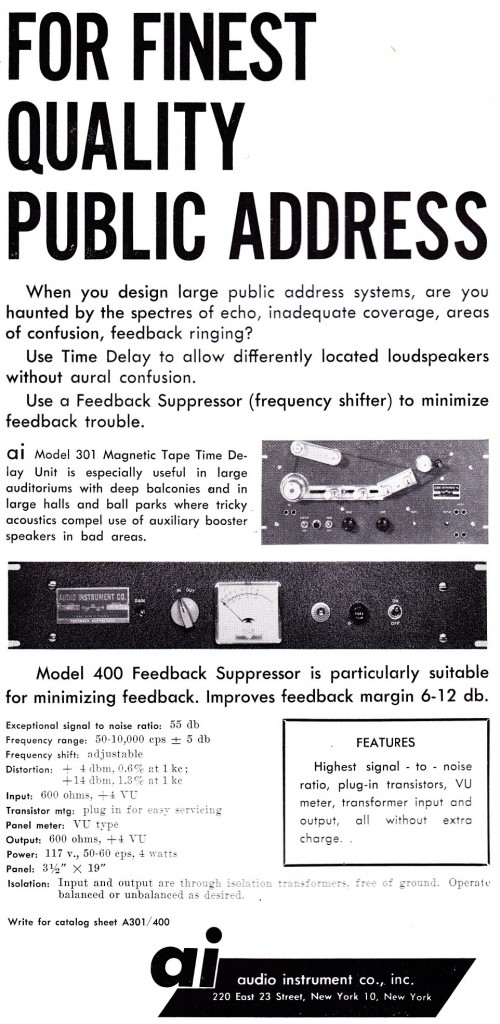 I had a live-sound mixing job this past weekend. The system that was hired was quite nice which made the job pretty easy. Thanks to hypercardiod microphones, graphic EQs, and stage monitors, feedback is not really a problem with concert sound these days; instead we tend to wrestle with volume levels, stage volume in particular. Above are two early high-tech methods of dealing with sound-reinforcement issues. The audio instruments model 301 time delay is a tape-echo machine which was intended not as a creative effect but instead to time-align speakers in a multiple-speaker system. As far as i can recall, this concept was made popular by the Grateful Dead in their massive arena systems of the 70s and later, and is now a defacto part of most large sound installations. Below that unit is the AI model 400 feedback supressor. Rather than employing frequency filters or dynamic control, the model 400 is one of an early category of feedback supressor (ALTEC made a similar product and I imagine there are others as well) that reduces system-wide feedback by shifting the entire frequency spectrum by some small amount, 1 or 2 hertz I imagine. The result? What goes ‘IN’ to the system is never the same as what goes ‘OUT’ of the system, so any ‘feedback’ is never linear and therefore a stated 6 to 12 db of additional gain becomes available. This is a fascinating concept that never went very far for some obvious reasons. You might never notice a shift of 2 hz on a violin part or a human voice, but bass guitar or organ? That could easily result in a 25% sharpening or flatting of the note. Bad news. I don’t know exactly what lead to the discontinuation of these sorts of devices, but I imagine that it may have been at least partially due to improvements in filter design that allowed inexpensive graphic EQs and fully-adjustable parametric EQs in the 1970s. I am very curious to know what feedback DID sound like when one of these frequency shifters is used: is it a long gliss up or down the pitch range to the maximum frequency response of the system? Anyone have experience with this?
I had a live-sound mixing job this past weekend. The system that was hired was quite nice which made the job pretty easy. Thanks to hypercardiod microphones, graphic EQs, and stage monitors, feedback is not really a problem with concert sound these days; instead we tend to wrestle with volume levels, stage volume in particular. Above are two early high-tech methods of dealing with sound-reinforcement issues. The audio instruments model 301 time delay is a tape-echo machine which was intended not as a creative effect but instead to time-align speakers in a multiple-speaker system. As far as i can recall, this concept was made popular by the Grateful Dead in their massive arena systems of the 70s and later, and is now a defacto part of most large sound installations. Below that unit is the AI model 400 feedback supressor. Rather than employing frequency filters or dynamic control, the model 400 is one of an early category of feedback supressor (ALTEC made a similar product and I imagine there are others as well) that reduces system-wide feedback by shifting the entire frequency spectrum by some small amount, 1 or 2 hertz I imagine. The result? What goes ‘IN’ to the system is never the same as what goes ‘OUT’ of the system, so any ‘feedback’ is never linear and therefore a stated 6 to 12 db of additional gain becomes available. This is a fascinating concept that never went very far for some obvious reasons. You might never notice a shift of 2 hz on a violin part or a human voice, but bass guitar or organ? That could easily result in a 25% sharpening or flatting of the note. Bad news. I don’t know exactly what lead to the discontinuation of these sorts of devices, but I imagine that it may have been at least partially due to improvements in filter design that allowed inexpensive graphic EQs and fully-adjustable parametric EQs in the 1970s. I am very curious to know what feedback DID sound like when one of these frequency shifters is used: is it a long gliss up or down the pitch range to the maximum frequency response of the system? Anyone have experience with this?
Categories
2 replies on “State of the Art Sound Reinforcement c. 1961”
Don’t know, but it’s an idea I’d thought of myself at one time. I’d like to see a schematic for this one.
Altec Lansing 1620A… Today DBX AFS224 and digitally well in so many DSP controllers…